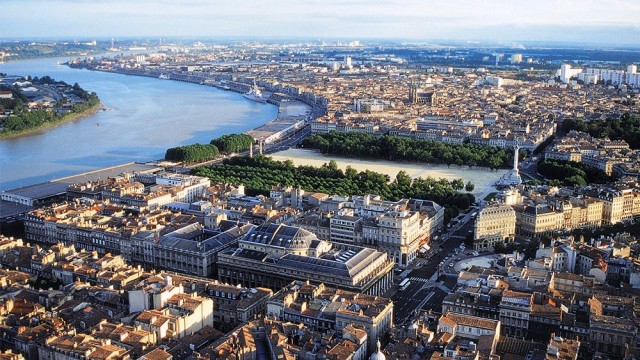Bordeaux
BORDEAUX IS THE eighth-largest city in FRANCE, and the capital of the historic southwestern province of Aquitaine. Bordeaux is also considered the wine capital of the world, and has been famous for its viticulture since the days of the Roman Empire. Unlike other major French cities, Bordeaux is not known for its energetic lifestyle or major industrial output; instead, the Bordelais take pride in their region's more relaxed pace of life and the spirit of elegance and refinement that characterizes much of the city and the region.
The city of Bordeaux arose as a Gallo-Roman port (Burdigala) on the river Garonne at the head of the large estuary the Gironde, which flows into the ATLANTIC OCEAN about 56 mi (90 km) to the northwest. It became the chief city of Aquitaine from the early Middle Ages, before this region became part of the kingdom of France. In fact, from 1152 to 1453, Bordeaux was an English city, the jewel in a string of French possessions held by the English kings until they were finally chased out at the end of the Hundred Years' War. Even after this date, Bordeaux remained the chief supplier of wine to England and other northern European states.

The city's wealth continued to grow with the development of Atlantic sea trade in the 17th century, primarily through the growth of refineries for sugar, which arrived in Bordeaux's ports directly from France's colonies in the West Indies. Revenues from the sugar and wine industries reshaped the city, which underwent a massive urban renewal in the 18th century, resulting in much of the city's present appearance, notably the Place Royale (today's Place de la Bourse) and the Grand Theatre.
Today's Bordeaux is a varied mixture of medieval churches, 18th-century squares, and more modern developments such as the massive suspension bridge across the Garonne, the Pont d'Aquitaine, opened in 1967. Several Gothic churches dominate Bordeaux's skyline owing to a general lack of skyscrapers. Notable among these is the Cathedral of Saint-Andre and the basilicas of Saint Seurin and Saint-Michel, all three of which were declared United Nations World Heritage sites in 1998 as important stops on the pilgrimage routes to Santiago de Compostela. Renaissance and neoclassical buildings include the Grosse Cloche, a tall clock tower that is one of the symbols of the city, and the Palais Rohan, the former archiepiscopal palace and now the city hall. Louis XV residences in Bordeaux are among the finest of French architecture.
In 2000, a plan was introduced to renovate the Garonne quaysides, which stretch for miles in a graceful unified arc along the curve of the river. City improvements such as this continue to be funded by wine revenues. Bordeaux's 57 different appellations (varieties) of wine are produced on roughly 20,000 acres (8,000 hectares) of surrounding countryside by 3,000 independent chateaus, 60 wine cooperatives, and the city's 400 wine merchants. The city's population is nearly 219,000 (1999). Many residents are occupied in some form with the wine industry but increasingly are also employed in aeronautics and aerospace technologies and the manufacture of chemical and pharmaceutical products.